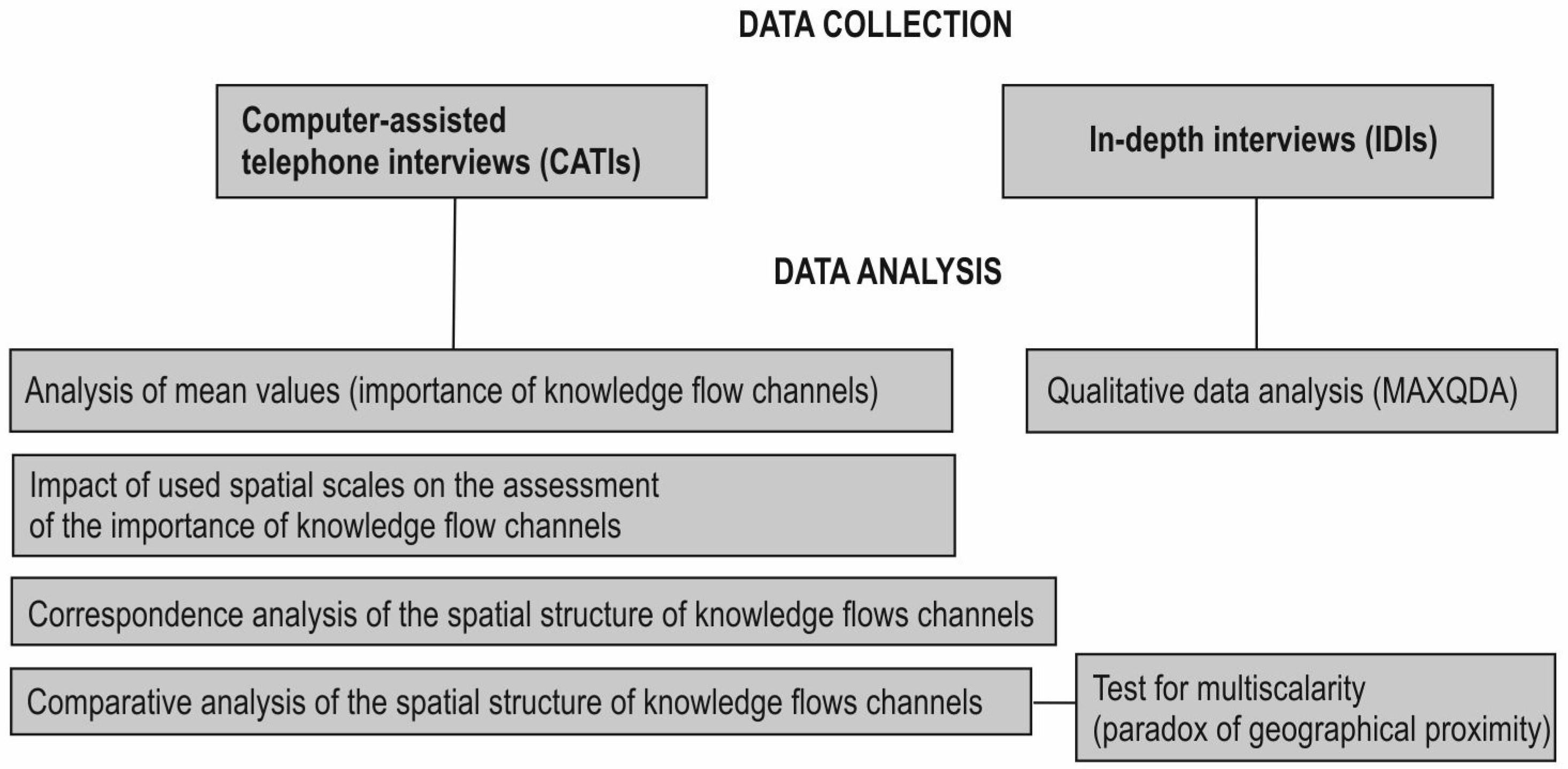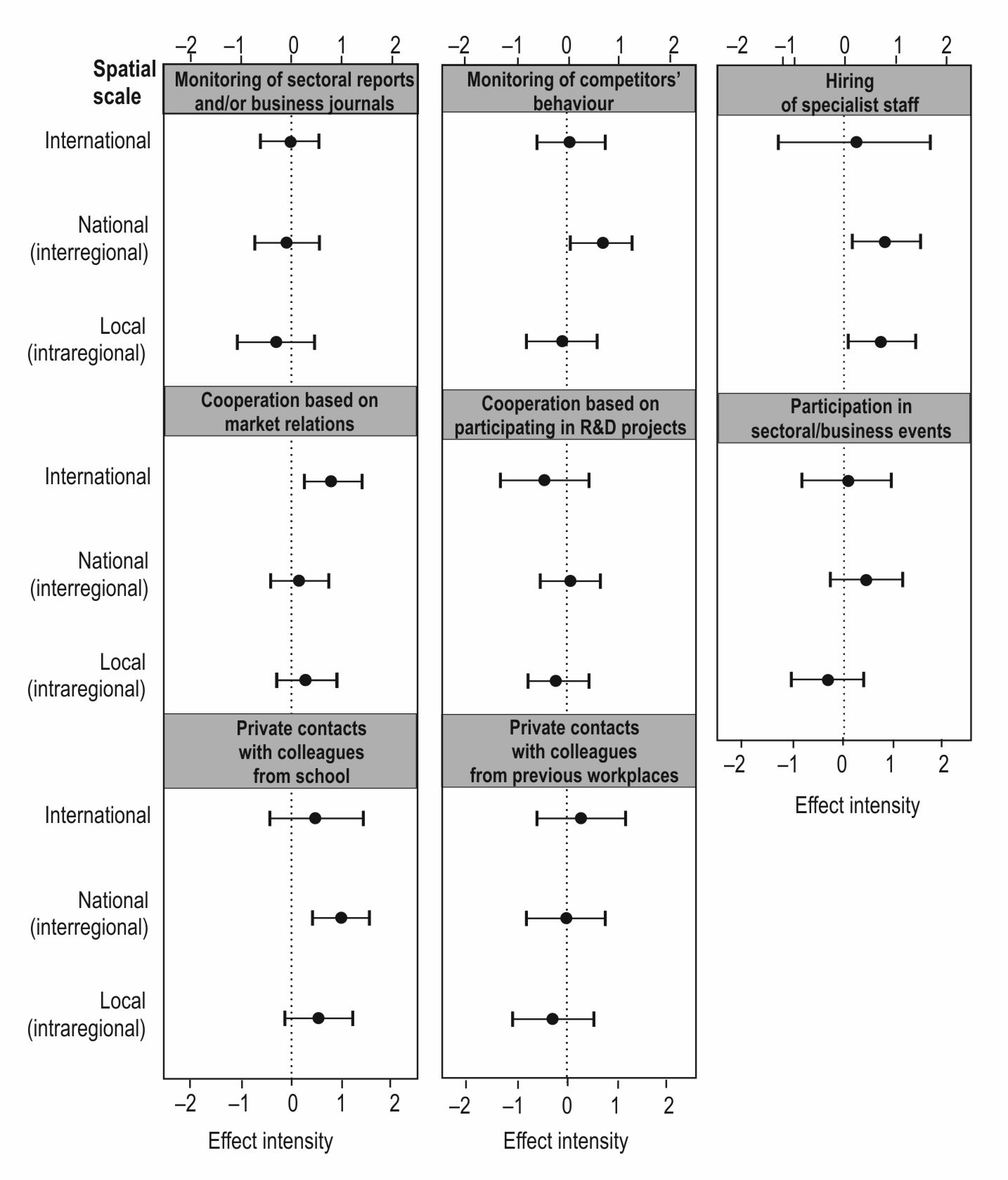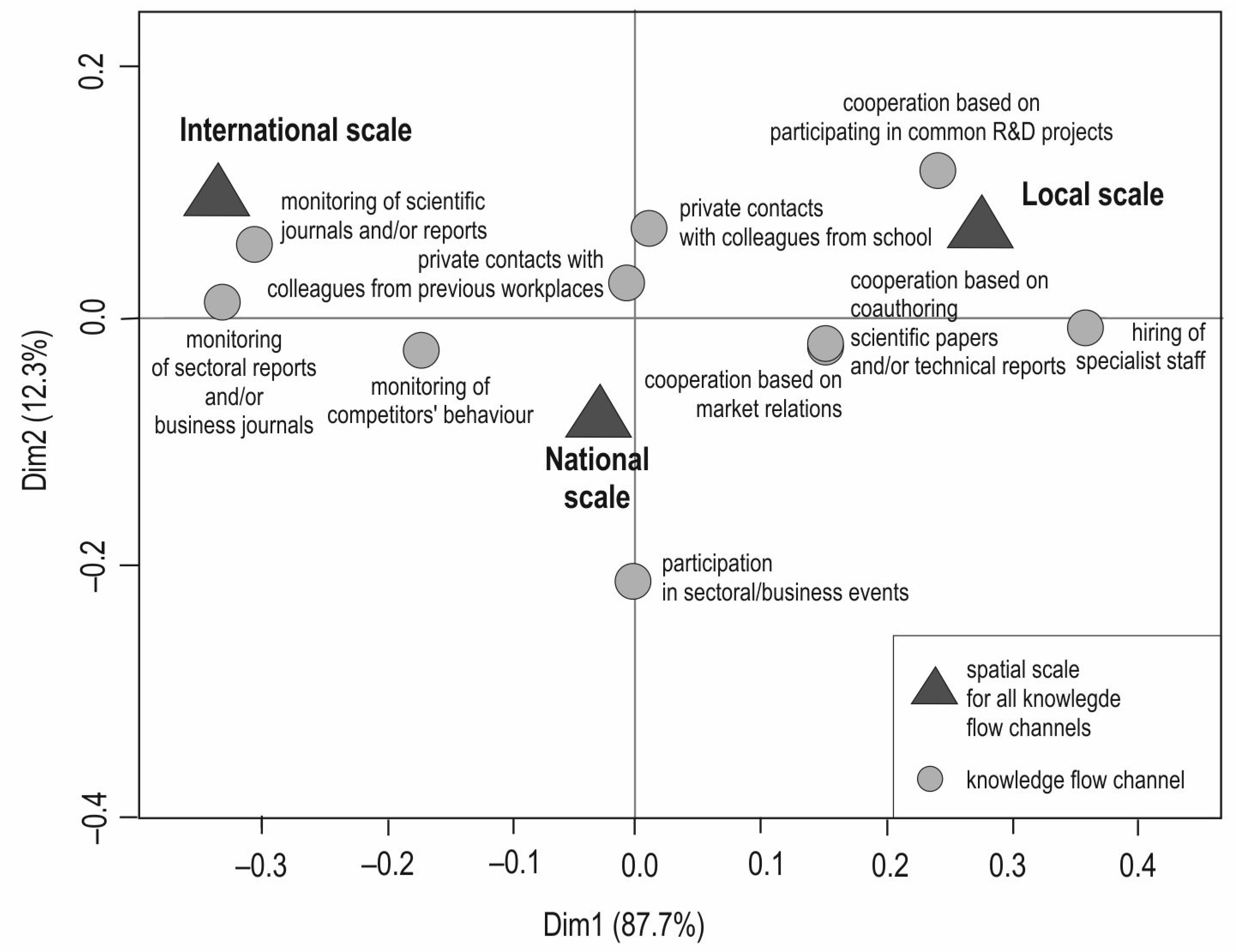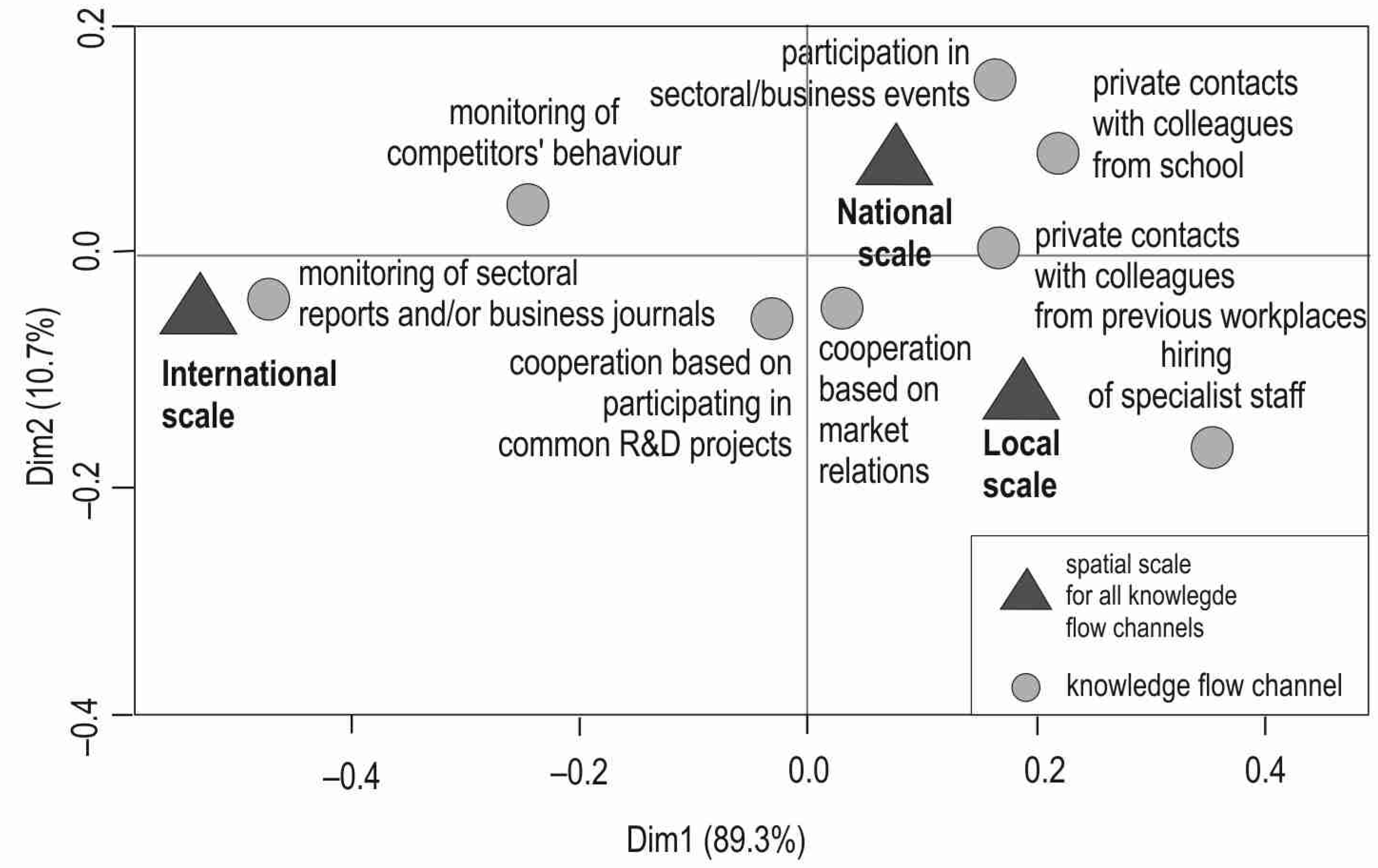Geographical Proximity Paradox Revisited: The Case of IT Service SMEs in Poland
Abstract
1. Introduction
1.1. Important Knowledge Flow Channels
- Collaboration based on social contacts [12,21,24], including a variety of mechanisms: Market relationships (traded knowledge flows according to Trippl et al. [30]); collaboration between inventors and patent citations [31,32,33], co-authorship or citation of research papers [34,35]; project-based collaboration (including participation in EU research programs [36,37,38]); and informal personal contacts (untraded relationships, according to Trippl et al. [30]) of managers and engineers (with colleagues from previous institutions or workplaces [39,40])
1.2. Spatiality of Knowledge Flows
1.3. Paradox of Geographical Proximity
2. Materials and Methods
3. Results
3.1. Importance of Knowledge Flow Channels
3.2. Impact of Spatial Scales on Assessment of the Importance of Knowledge Flow Channels
3.3. Spatial Structure of Multiscalar Knowledge Flows
3.4. Paradox of Geographical Proximity
4. Discussion and Conclusions
Funding
Acknowledgments
Conflicts of Interest
References
- Giuliani, E. The selective nature of knowledge networks in clusters: Evidence from the wine industry. J. Econ. Geogr. 2007, 7, 139–168. [Google Scholar] [CrossRef]
- Bathelt, H.; Malmberg, A.; Maskell, P. Clusters and Knowledge: Local Buzz, Global Pipelines and the Process of Knowledge Creation. Prog. Hum. Geog. 2004, 28, 31–56. [Google Scholar] [CrossRef]
- Grabher, G. Cool projects, boring institutions: Temporary collaboration in social context. Reg. Stud. 2002, 36, 205–214. [Google Scholar] [CrossRef]
- Smith, J.; Powell, W. Knowledge Networks as Channels and Conduits: The Effects of Spillovers in the Boston Biotechnology Community. Organ. Sci. 2004, 15, 5–21. [Google Scholar] [CrossRef]
- Martin, R. The new “geographical turn” in economics: Some critical reflections. Camb. J. Econ. 1999, 23, 65–91. [Google Scholar] [CrossRef]
- Boschma, R.A.; Frenken, K. The Spatial Evolution of Innovation Networks: A Proximity Perspective. In The Handbook of Evolutionary Economic Geography; Boschma, R.A., Martin, R., Eds.; Edward Elgar: Cheltenham, UK, 2010; pp. 120–135. [Google Scholar]
- Blažek, J.; Žižalova, P.; Rumpel, P.; Skokan, K. Where Does the Knowledge for Knowledge-intensive Industries Come From? The Case of Biotech in Prague and ICT in Ostrava. Eur. Plan. Stud. 2011, 19, 1277–1303. [Google Scholar] [CrossRef]
- Fitjar, R.D.; Huber, F.; Rodríguez-Pose, A. Not too close, not too far: Testing the Goldilocks principle of ‘optimal’ distance in innovation networks. Ind. Innov. 2016, 23, 465–487. [Google Scholar] [CrossRef]
- Huber, F. Knowledge-sourcing of R&D workers in different job positions: Contextualising external personal knowledge networks. Res. Policy 2013, 42, 167–179. [Google Scholar]
- Sorenson, O. Social networks and industrial geography. J. Evol. Econ. 2003, 13, 513–527. [Google Scholar] [CrossRef]
- Tödtling, F.; Skokan, K.; Höglinger, C.; Rumpel, P.; Grillitsch, M. Innovation and knowledge sourcing of modern sectors in old industrial regions: Comparing software firms in Moravia-Silesia and Upper Austria. Eur. Urban Reg. Stud. 2013, 20, 188–205. [Google Scholar] [CrossRef]
- Martin, R.; Moodysson, J. Innovation in symbolic industries: The geography and organization of knowledge sourcing. Eur. Plan. Stud. 2011, 19, 1183–1203. [Google Scholar] [CrossRef]
- Schmidt, S. Balancing the spatial localisation ‘Tilt’: Knowledge spillovers in processes of knowledge-intensive services. Geoforum 2015, 65, 374–386. [Google Scholar] [CrossRef]
- Micek, G.; Piziak, B. Wpływ bliskości międzyorganizacyjnej na rozwój usług IT w Krakowie i na Górnym Śląsku. Stud. Ekon. Zeszyty Nauk. UE w Katowicach 2017, 320, 107–128. [Google Scholar]
- Pučėtaitė, R.; Lämsä, A.M. Developing organizational trust through advancement of employees’ work ethic in a post-socialist context. J. Bus. Ethics 2008, 82, 325–337. [Google Scholar] [CrossRef]
- Sankowska, A. Relationships between organizational trust, knowledge transfer, knowledge creation, and firm’s innovativeness. Learn. Organ. 2013, 20, 85–100. [Google Scholar] [CrossRef]
- Faulconbridge, J. Global architects: Learning and innovation through communities and constellations of practice. Environ. Plan. 2010, 42, 2842–2858. [Google Scholar] [CrossRef]
- Kloosterman, R.C. Walls and bridges: Knowledge spillover between ‘superdutch’ architectural firms. J. Econ. Geogr. 2008, 8, 545–563. [Google Scholar] [CrossRef]
- Górecki, J. (Ed.) Business Services in Poland 2018; Association of Business Service Leaders (ABSL): Warsaw, Poland, 2018. [Google Scholar]
- Micek, G. FDI trends in the business services sector: The case of Poland. In Foreign Investment in Eastern and Southern Europe after 2008. Still a Lever of Growth? Galgoczi, B., Drahokoupil, J., Bernaciak, M., Eds.; European Trade Union Institute: Brussels, Belgium, 2015; pp. 297–318. [Google Scholar]
- Martin, R.; Moodysson, J. Comparing knowledge bases: On the geography and organization of knowledge sourcing in the regional innovation system of Scania, Sweden. Eur. Urban Reg. Stud. 2013, 20, 170–187. [Google Scholar] [CrossRef]
- Tödtling, F.; Lengauer, L.; Höglinger, C. Knowledge sourcing and innovation in “thick” and “thin” regional innovation systems—Comparing ICT firms in two Austrian regions. Eur. Plan. Stud. 2011, 19, 1245–1276. [Google Scholar] [CrossRef]
- Jaffe, A.B.; Trajtenberg, M.; Henderson, R. Geographic Localization of Knowledge Spillovers as Evidenced by Patent Citations. Q. J. Econ. 1993, 108, 577–598. [Google Scholar] [CrossRef]
- Menzel, M.-P.; Fornahl, D. Cluster life cycles—Dimensions and rationales of cluster evolution. Ind. Corp. Chang. 2010, 19, 205–238. [Google Scholar] [CrossRef]
- Bienkowska, D.; Lundmark, M.; Malmberg, A. Brain circulation and flexible adjustment: Labour mobility as a cluster advantage. Geogr. Ann. B 2011, 93, 21–39. [Google Scholar] [CrossRef]
- Eriksson, R.H. Localized Spillovers and Knowledge Flows: How does proximity influence the performance of plants? Econ. Geogr. 2011, 87, 127–152. [Google Scholar] [CrossRef]
- Tabata, M. The absorption of Japanese engineers into Taiwan’s TFT-LCD industry: Globalization and transnational talent diffusion. Asian Surv. 2012, 52, 571–594. [Google Scholar]
- Buenstorf, G.; Geissler, M. The origins of entrants and the geography of the German laser industry. Pap. Reg. Sci. 2011, 90, 251–270. [Google Scholar] [CrossRef]
- Cusmano, L.; Morrison, A.; Pandolfo, E. Spinoff and Clustering: A return to the Marshallian district. Camb. J. Econ. 2015, 39, 49–66. [Google Scholar] [CrossRef]
- Trippl, M.; Tödtling, F.; Lengauer, L. Knowledge Sourcing Beyond Buzz and Pipelines: Evidence from the Vienna Software Sector. Econ. Geogr. 2009, 85, 443–462. [Google Scholar] [CrossRef]
- Ter Wal, A.L.J. Cluster emergence and network evolution: A longitudinal analysis of the inventor network in Sophia-Antipolis. Reg. Stud. 2013, 47, 651–668. [Google Scholar] [CrossRef]
- Cassi, L.; Plunket, A. Proximity, network formation and inventive performance: In search of the proximity paradox. Ann. Regional Sci. 2014, 53, 395–422. [Google Scholar] [CrossRef]
- Cassi, L.; Plunket, A. Research Collaboration in Co-inventor Networks: Combining Closure, Bridging and Proximities. Reg. Stud. 2015, 49, 936–954. [Google Scholar] [CrossRef]
- Frenken, K.; Hardeman, S.; Hoekman, J. Spatial scientometrics. Towards a cumulative research program. J. Infometr. 2009, 3, 222–232. [Google Scholar] [CrossRef]
- Ponds, R.; van Oort, F.; Frenken, K. The geographical and institutional proximity of research collaboration. Pap. Reg. Sci. 2007, 86, 423–443. [Google Scholar] [CrossRef]
- Autant-Bernard, C.; Fadairo, M.; Massard, N. Knowledge diffusion and innovation policies within the European regions: Challenges based on recent empirical evidence. Res. Policy 2013, 42, 196–210. [Google Scholar] [CrossRef]
- Balland, P.-A. Proximity and the Evolution of Collaboration Networks: Evidence from Research and Development Projects within the Global Navigation satellite System (GNSS) Industry. Reg. Stud. 2012, 46, 741–756. [Google Scholar] [CrossRef]
- Basile, R.; Capello, R.; Caragliu, A. Technological interdependence and regional growth in Europe: Proximity and synergy in knowledge spillovers. Pap. Reg. Sci. 2012, 91, 697–722. [Google Scholar] [CrossRef]
- Amin, A.; Roberts, J. Knowing in action: Beyond communities of practice. Res. Policy 2016, 37, 353–369. [Google Scholar] [CrossRef]
- Dahl, M.S.; Pedersen, C.O.R. Social networks in the R&D process: The case of the wireless communication industry around Aalborg, Denmark. J. Eng. Technol Manag. 2005, 22, 75–92. [Google Scholar]
- Bathelt, H.; Schuldt, N.A. Between luminaires and meat grinders: International trade fairs as temporary clusters. Reg. Stud. 2008, 42, 853–868. [Google Scholar] [CrossRef]
- Rychen, F.; Zimmermann, J.-B. Clusters in the Global Knowledge-based Economy: Knowledge Gatekeepers and Temporary Proximity. Reg. Stud. 2008, 42, 767–776. [Google Scholar] [CrossRef]
- Schuldt, N.; Bathelt, H. International Trade Fairs and Global Buzz. Part II: Practices of Global Buzz. Eur. Plan. Stud. 2011, 19, 1–22. [Google Scholar] [CrossRef]
- Bathelt, H.; Turi, P. Local, global and virtual buzz: The importance of face-to-face contact in economic interaction and possibilities to go beyond. Geoforum 2011, 42, 520–529. [Google Scholar] [CrossRef]
- Huber, F. Do clusters really matter for innovation practices in Information Technology? Questioning the significance of technological knowledge spillovers. J. Econ. Geogr. 2012, 12, 107–126. [Google Scholar] [CrossRef]
- Huber, F. On the Role and Interrelationship of Spatial, Social and Cognitive Proximity: Personal Knowledge Relationships of R&D Workers in the Cambridge Information Technology Cluster. Reg. Stud. 2012, 46, 1169–1182. [Google Scholar]
- Storper, M.; Venables, A.J. Buzz: Face-to-face contact and the urban economy. J. Econ. Geogr. 2004, 4, 351–370. [Google Scholar] [CrossRef]
- Bathelt, H. Geographies of Production: Growth Regimes in Spatial Perspective (II)—Knowledge Creation and Growth in Clusters. Prog. Hum. Geog. 2005, 29, 204–216. [Google Scholar] [CrossRef]
- Schamp, E.W. Coevolution von Wissen und Raum?—Ein kritischer Bericht aus der Wirtschaftsgeographie. disP—Plan. Rev. 2008, 45, 70–78. [Google Scholar] [CrossRef]
- Ben Letaifa, S.; Rabeau, Y. Too close to collaborate? How geographic proximity could impede entrepreneurship and innovation. J. Bus. Res. 2013, 66, 2071–2078. [Google Scholar] [CrossRef]
- Hassink, R.; Lagendijk, A. The dilemmas of interregional institutional learning. Environ. Plan C 2011, 19, 65–84. [Google Scholar] [CrossRef]
- Moodysson, J. Principles and practices of knowledge creation: On the organization of ‘buzz’ and ‘pipelines’ in life science communities. Econ. Geogr. 2008, 84, 449–469. [Google Scholar] [CrossRef]
- Lorentzen, A. Knowledge networks in local and global space. Entrep. Region. Dev. 2008, 20, 533–545. [Google Scholar] [CrossRef]
- Andersson, M.; Karlsson, C. The role of accessibility for the performance of regional innovation systems. In Knowledge Spillovers and Knowledge Management; Karlsson, C., Flensburg, P., Hörte, S.-A., Eds.; Elgar: Cheltenham, UK, 2004; pp. 283–310. [Google Scholar]
- Breschi, S.; Lissoni, F. Mobility of skilled workers and co-invention networks: An anatomy of localized knowledge flows. J. Econ. Geogr. 2009, 9, 439–468. [Google Scholar] [CrossRef]
- Moodysson, J.; Jonsson, O. Knowledge collaboration and proximity: The spatial organization of biotech innovation projects. Eur. Urban Reg. Stud. 2007, 14, 115–131. [Google Scholar] [CrossRef]
- Ženka, J.; Novotný, J.; Slach, O.; Ivan, I. Spatial Distribution of Knowledge-Intensive Business Services in a Small Post-Communist Economy. J. Know. Econ. 2017, 8, 385–406. [Google Scholar] [CrossRef]
- Döring, T.; Schnellenbach, J. What do we know about geographical knowledge spillovers and regional growth? A survey of the literature. Reg. Stud. 2006, 40, 375–395. [Google Scholar] [CrossRef]
- Aarstad, J.; Kvitastein, O.A.; Jakobsen, S.-E. Local buzz, global pipelines, or simply too much buzz? A critical study. Geoforum 2016, 75, 129–133. [Google Scholar] [CrossRef]
- Sommerville, P. Multiscalarity and Neighbourhood Governance. Public Policy Admin. 2011, 26, 81–105. [Google Scholar] [CrossRef]
- Poon, J.P.H.; Hsu, J.-Y.; Jeongwook, S. The geography of learning and knowledge acquisition among Asian latecomers. J. Econ. Geogr. 2006, 6, 541–559. [Google Scholar] [CrossRef][Green Version]
- Boschma, R.A. Proximity and innovation. A critical assessment. Reg. Stud. 2005, 39, 61–74. [Google Scholar] [CrossRef]
- Nooteboom, B.; van Haverbeke, W.; Duysters, G.; Gilsing, V.; van den Oord, A. Optimal cognitive distance and absorptive capacity. Res. Policy 2007, 36, 1016–1034. [Google Scholar] [CrossRef]
- Lambooy, J.G.; Boschma, R.A. Evolutionary economics and regional policy. Ann. Reg. Sci. 2001, 35, 113–131. [Google Scholar] [CrossRef]
- Grabher, G. The Embedded Firm. On the Socioeconomics of Industrial Networks; Routledge: London, UK, 1993. [Google Scholar]
- Martin, R.; Sunley, P.; Gardiner, B.; Tyler, P. How regions react to recessions: Resilience and the role of economic structure. Reg. Stud. 2016, 50, 561–585. [Google Scholar] [CrossRef]
- Broekel, T.; Boschma, R.A. Knowledge networks in the Dutch aviation industry: The proximity paradox. J. Econ. Geogr. 2012, 12, 409–433. [Google Scholar] [CrossRef]
- Balland, P.-A.; de Vaan, M.; Boschma, R.A. The dynamics of interfirm networks along the industry life cycle: The case of the global video game industry, 1987–2007. J. Econ. Geogr. 2013, 13, 741–765. [Google Scholar] [CrossRef]
- Ter Wal, A.L.J.; Boschma, R.A. Applying social network analysis in economic geography: Framing some key analytic issues. Ann. Reg. Sci. 2009, 43, 739–756. [Google Scholar] [CrossRef]
- Micek, G. Bliskość Geograficzna Przedsiębiorstw Zaawansowanego Przemysłu i Usług a Przepływy Wiedzy; Institute of Geography and Spatial Management UJ: Kraków, Poland, 2017; pp. 1–368. [Google Scholar]
- Guzik, R.; Micek, G. Impact of Delocalisation on the European Software Industry. In The Moving Frontier: The Changing Geography of Production in Labour Intensive Industries; Labrianidis, L., Ed.; Ashgate: Aldershot, UK, 2008; pp. 229–254. [Google Scholar]
- Micek, G. Investigating the emergence of software development centres in Central and Eastern Europe. Geogr. Pol. 2009, 82, 21–33. [Google Scholar] [CrossRef]






| Type of Knowledge Flow Channel | Mean Value | |
|---|---|---|
| Technological Knowledge | Business Knowledge | |
| Monitoring of scientific journals and/or reports | 3.11 | 2.82 |
| Monitoring of sectoral reports and/or business journals | 2.85 | – |
| Monitoring of competitors’ behavior | 2.71 | 3.09 |
| Hiring of specialist staff | 3.46 | 3.24 |
| Cooperation based on market relations | 4.07 | 4.06 |
| Cooperation based on co-authoring of scientific papers and/or technical reports | 2.34 | – |
| Cooperation based on participating in common R&D projects | 2.69 | 2.48 |
| Participation in sectoral/business events | 3.05 | 2.89 |
| Private contacts with colleagues from school | 3.19 | 2.73 |
| Private contacts with colleagues from previous workplaces | 2.91 | 3.23 |
| Knowledge Flow Channel | Spatial Scale (% of Total Population, N = 67,065) | Share Differences in Using Local Scale and Below-Listed One | |||
|---|---|---|---|---|---|
| Local | National | International | National | International | |
| Participation in sectoral/business events | 24 | 58 | 15 | +34 | −9 |
| Monitoring of competitors’ behavior | 25 | 56 | 29 | +31 | +4 |
| Monitoring of scientific journals and/or reports | 21 | 50 | 34 | +29 | +13 |
| Monitoring of sectoral reports and/or business journals | 20 | 58 | 37 | +28 | +17 |
| Private contacts with colleagues from previous workplaces | 32 | 50 | 23 | +18 | −9 |
| Cooperation based on market relations | 38 | 53 | 17 | +15 | −19 |
| Private contacts with colleagues from school | 35 | 49 | 24 | +14 | −11 |
| Cooperation based on co-authoring scientific papers and/or technical reports | 36 | 49 | 16 | +13 | −20 |
| Hiring of specialist staff | 41 | 44 | 9 | +3 | −32 |
| Cooperation based on participating in common R&D projects | 42 | 41 | 16 | −1 | −26 |
| Knowledge Flow Channel | Spatial Scale (% of Total Population, N = 67,065) | Share Differences in Using Local Scale and Below-Listed One | |||
|---|---|---|---|---|---|
| Local | National | International | National | International | |
| Monitoring of competitors’ behavior | 26 | 59 | 31 | +33 | +5 |
| Monitoring of sectoral reports and/or business journals | 25 | 51 | 42 | +26 | +17 |
| Private contacts with colleagues from school | 27 | 52 | 8 | +25 | −19 |
| Participation in sectoral/business events | 28 | 62 | 11 | +24 | −17 |
| Cooperation based on market relations | 34 | 56 | 12 | +22 | −22 |
| Cooperation based on participating in common R&D projects | 35 | 55 | 22 | +20 | −13 |
| Private contacts with colleagues from previous workplaces | 35 | 54 | 19 | +19 | −16 |
| Hiring of specialist staff | 39 | 43 | 5 | +4 | −34 |
© 2019 by the author. Licensee MDPI, Basel, Switzerland. This article is an open access article distributed under the terms and conditions of the Creative Commons Attribution (CC BY) license (http://creativecommons.org/licenses/by/4.0/).
Share and Cite
Micek, G. Geographical Proximity Paradox Revisited: The Case of IT Service SMEs in Poland. Sustainability 2019, 11, 5770. https://doi.org/10.3390/su11205770
Micek G. Geographical Proximity Paradox Revisited: The Case of IT Service SMEs in Poland. Sustainability. 2019; 11(20):5770. https://doi.org/10.3390/su11205770
Chicago/Turabian StyleMicek, Grzegorz. 2019. "Geographical Proximity Paradox Revisited: The Case of IT Service SMEs in Poland" Sustainability 11, no. 20: 5770. https://doi.org/10.3390/su11205770
APA StyleMicek, G. (2019). Geographical Proximity Paradox Revisited: The Case of IT Service SMEs in Poland. Sustainability, 11(20), 5770. https://doi.org/10.3390/su11205770





